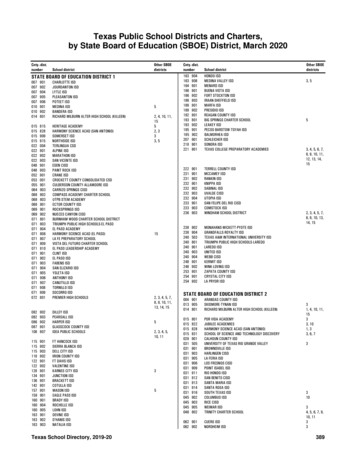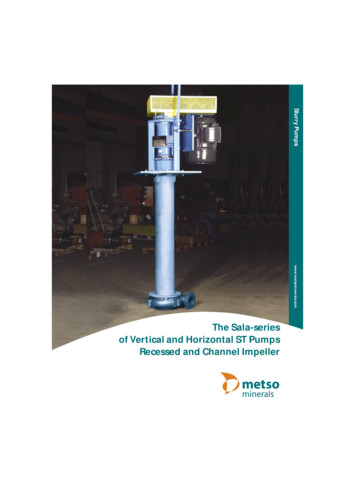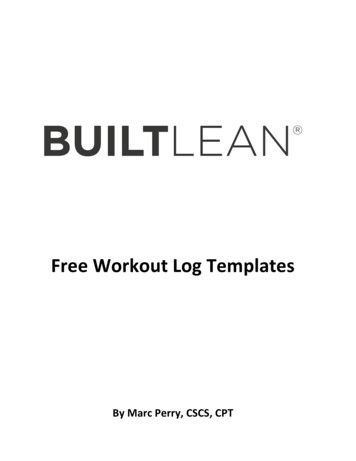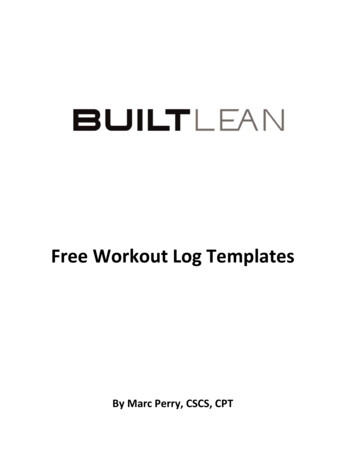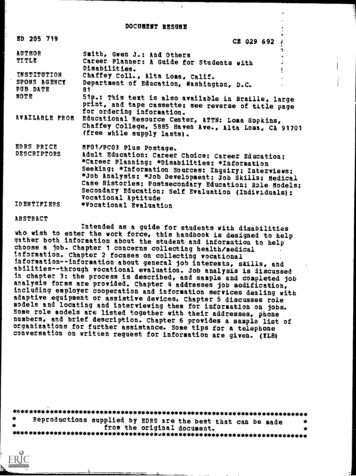
Transcription
DOCUMENT RESUMEED 205 719AUTHORTITLEINSTITUTIONSPONS AGENCYPUB DATENOTEAVAILABLE FROMEDRS PRICEDESCRIPTORSIDENTIFIERSCE 029 692'1Smith, Gwen J.: And OthersCareer Planner: A Guide for Students withDisabilities.Chaffey Coll., Alta Loma, Calif.Department of Education, Washington, D.C.:48151p.: This text is also available in Braille, largeprint, and tape cassette: see reverse of title pagefor ordering information.Educational Resource Center, ATTN: Loma Hopkins,Chaffey College, 5885 Haven Ave., Alta Loma, CA 91701(free while supply lasts).MF01/PC03 Plus Postage.Adult Education: Career Choice: Career Education:*Career Planning; *Disabilities: *InformationSeeking; *Information Sources: Inquiry; Interviews:*Job Analysis: *Job Development; Job Skills; MedicalCase Histories; Postsecondary Education; Bole Models:Secondary Edncation; Self Evaluation (Individuals:Vocational Aptitude*Vocational EvaluationABSTRACTIntended as a guide for students with disabilitieswho wish to enter the work force, this handbook is designed to helpgather both information about the student and information to helpchoose a job. Chapter 1 concerns collecting health /medicalInformation. Chapter 2 focuses on collecting vocationalinformation--information about general job interests, skills, andabilities -- through vocational evaluation. Job analysis is discussedin chapter 3: the process is described, and sample and completed jobanalysis forms are provided. Chapter 4 addresses job modification,including employer cooperation and information services dealing withadaptive equipment or assistive devices, Chapter 5 discusses rolemodels and locating and interviewing them for information on jobs.Some role models are listed together with their addresses, phonenumbers, and brief description. Chapter 6 provides a sample list oforganizations for further assistance. Some tips for a telephoneconversation on written request for information are given. *************************Reproductions supplied by EDRS are the best that can be made*from the original *********************************
"PERMISSION TO REPRODUCE THISMATERIAL HAS BEEN GRANTED BYU.S. DEPARTMENT' OP REALM.EDUCATION A WELFARENATIONAL INSTITUTE OfEDUCATIONTHIS DOCUMENT HAS BEEN REPRO.OUCEO EXACTLY AS RECEIVED FROMTHE PERSON OR ORGANIZATION ORIGIN.ATING IT POINTS OF VIEW OR OPINIONSSTATED DO NOT NECESSARILY REPRESENT OFFICIAL NATIONAL INSTITUTE OFEOUCATION POSITION OR POLICYoberk. 14 rri5TO THE EDUCATIONAL RESOURCESINFORMATION CENTER (ERIC)."CAREER PLANNER:A GUIDE FOR STUDENTS WITH DISABILITIESbyGwen J. SmithAdam BerensonSharlene SmithDeveloped as partial fulfillment for aVocational Education Project No. CC3-0-452Un4r Subpart 3 of P.L. 94.482Robert M. Harris, Project DirectorLoma J. Hopkins, Project ManagerOEducational Resource CenterChaffey Community College5885 Haven AvenueAlta Loma, CA 917011981
This project was supported in whole or in part by the U.S. Department ofEducation. However, the opinions expressed herein do not necessarily reflectthe position or policy of the U.S. Department of Education, and no officialendorsement by the U.S. Department of Education should be inferred.Typesetting by: Sharp Composition ServiceTyped by: Connie BredlauGraphics by: Judy HeapsThis publication is also available in Braille, large print, and tape cassette.Requests should be directed to:Braille:Pomona Valley Transcribers Guildc/o Ontario Public Library215 E. 'C' StreetOntario, CA 91764Large Print:Chaffey Community College (free)Educational Resource Center5885 Haven AvenueAlta Loma, CA 91701
TABLE OF CONTENTSFOREWORD1IINTRODUCTION21. HEALTH INFORMATION4iSample Form'2. VOCATIONAL INFORMATION8,3. JOB ANALYSIS12Sample Forms164. JOB MODIFICATIONSAssistive DevicesSample Forms824-26285. ROLE MODELS32Sample Letter34Resource Contacts.366. RESOURCES FOR FURTHER HELP38Sample Letter41Resource Contacts42SUMMARY4741
FOREWORDThis is an exciting time for those of us who are putting this guidetogether. The United Nations has declared 1981 a- the International Year of the Disabled. The theme for the year is "FullParticipation of Disabled Persons in the Life of their Society."Communities are encouraged to work with agencies at their locallevel. In California, both the Governor's Committee for Employment of the Handicapped and the Department of Rehabilitationwill offer assistance and guidance to interested groups andindividuals.This guide is meant to encourage you to look at yourself as anable individual, instead of a disabled person. Disabled persons areindividuals with the needs, interests and abilities to function in asociety that, traditionally has had little ol no expectations forthem. In fact, it has often been considered unusual for a disabledperson to expect to work or even get around in the community.Along with opportunity comes the responsibility of makingchoices. Hopefully, this guide will provide you with many oppor-tunities to make choices about the most,important person inyour lifeYOU.The authors wish to thank the following people at ChaffeyCollege for their special support in this project:Connie Bredlau, Senior Typist ClerkSharp Composition Service, TypesetterPreston Chipp :, Vocational EvaluatorCecile Davis, Physical/Communicatke DisabilitiesResource SpecialistFrances Force, Learning AssistantJudy Heaps, Graphic ArtistPat Larson, Resource TechnicianLaura Stewart, Teaching AssistantNancy Swanson, Teaching AssistantMarian Tyler, Instructional SpecialistIt,/
INTRODUCTIONYou have chosen to use this guide because you are thinkingabout entering the world of work.Each of you has some idea of what it is like to be a worker. Youknow people who work at many different kinds of jobs. Some ofthose jobs look interesting and you think about how you wouldperform in the same job.2C'0
This handbook is meant to be a guide for career planners whowish to enter the work force. For some of you, this will be a firstvisit. For others, who have worked before, this will be a returntrip. The most important thing to remember is that YOU are incharge of this trip.We believe that all career planners have a common interest. Theywant to find out as much as they can about themselves anddecide where they want to go in the worid of work. Work mayseem to be only a small part of our lives; however, our workchoices affect our lives in many ways. Who we spend our timewith, where we live, and how happily we live are decided by thework we do.Planning for a career is a research project for you. You are goingto gather two kinds of information. One kind of information isabout yourself. The second kind is about how to find information that will help you to decide on a particular job. The mostinteresting person in the world is YOU, so this should be anexciting project.13
1 START ----- HEALTH INFORMA'T'IONYou are ready to start by first getting information about yourhealth. A good place to begin is with your family doctor. If youdon't have a doctor, check with your school health service oryour county health department. These agencies can connect youwith other health services. County offices are listed in the whitepages of the telephone directory under the name of the county.Los Angeles, County of.)(Example4r6
You will need to have up-to-date information aboutourself.A yearly checkup is important. When you see the doctor, it is up'to you to get the information you want. You also have importantinformation to give the doctor. Together you can become part-1ners in staying healthy!Make a list of questions to ask the doctor, so that y ou willremember everything you want to know. Your doctor or healthdepartment can become important resources.-ItThe sample health information form may serve as a guide to helpyou and your counselor. The form will provide you %%ith practicalknowledge about your physical health.sI
CONFIDENTIAL HEALTH INFORMATIONName e)(zip code)Telephone Number (area code)Date of lest physical examinationName of DoctorAddress(city)(state)(telephone)Check any disease or condition which you n'w have or have had in the past.AllergyAsthmaConvulsions0inHeart DiseasePolioRheumatic aring
va:Name any other serious illness, injury, operation or disabling condition, and put an approximate date or the age when It happened.Name any medication(s) you are taking:1IMMI"Can you declibe any other disability which interferes with career plans you want to make?Date this form completedName of Doctor11
VOCATIONAL INFORMATIONIn Chapter 1, we talked about collecting health/medical information. Now, you will begin to collect vocational information. Thatis, information about your general job interests,skills and abilities.The process described is usual:y called a Vocational Evaluation.This term may not be familiar to you. After you have finishedthis chapter, you will have a better idea of what a vocationalevaluation is. The evaluation can help you to make better careerdecisions.Basically, a vocational evaluation is the process of finding theright job or career for yourself. During a vocational evaluationyou ask yourself such questions as:1)What do I like to do?2)What do I know how to do?3) What have I done in the past?4) What assistance will I need?A vocational evaluation is a way for you to discover enoughabout yourself, so that you can make better choices about a jobor a career.8'14.f)n.,
It's possible, of course, that you have no idea about what kind ofwork you want to do. You may never have thought about gettinga job. You may even have been told that you can't work and thatthere are no jobs for you. In a vocational evaluation you will findthat everyday abilities and skills are useful on a job.The purpose of a vocational evaluation is to let you know aboutthose skills that can be used on a job. For example, you mayhave had an erector set when you were young and now you likeLo play around with gadgets. A vocational evaluation will pointout that this kind of interest and ability means that you havegood manual dexterity. This is an ability to use your hands toproduce something. You might use this skill to assemble a lampor use a soldering gun. This could lead to a job as an assembler.A person who enioys physical activities usually does a lot ofwalking, lifting or carrying. A janitor, a construction worker, awaitress or a nurse's aid does these things as a part of the job.A vocational evaluation can be exciting. You can find out something new about yourself and use that information to see howmany suitable jobs are available.The Vocational Evaluator is a person who can be your partner indiscovering the things you need to know about yourself. Theevaluator is trained to assist you in this process. The evaluatorwill give you some tests and problems to work on. These arecalled ability tests, interest tests, and work sample tests. Some ofthe tests are written, but most of them are "hands on."If the word TEST means a big, red stop sign, think about thisthese are not tests that you can pass or fail. The test results arefor YOUR information. Think green for go.Ability tests are designed to find your strongest and weakestareas. A strong ability in math, for example, could lead to acareer in bookkeeping or accounting. Salespeople also use mathabilities.91 '1-I. t./1
An interest test can help you discover what kinds of jobs youwould like best. One man, who had been a baker for a long time,took a test and found that he had a strong interest in science.A young woman, who planned to be a lawyer, found that shereally had more interest in business machines.Work sample tests are just what they sound likea sample ofwhat a particular job requires. Have you ever gone into an icecream store and asked for a taste of the flavor of the month?You were checking it out before you spent your money on awhole scoop. You were using an experience to give you informa-tion before you made a decision. A work sample involves thesame decision making process.Should the Vocational Evaluator ask you to stand on first onefoot and then the other, he/she is checking your balance. If yourbalance is poor, you would not want to become a windowwasher. If your balance is good, then you can add that to yourlist of strengths, when you are planning y our career.Another example is checking your vision. A combination of goodeyesight and manual dexterity could lead to a job repairingwatches.Some of this information is based on "common sense." Thismeans your "common sense" continues to improve because ofyour experiences. You will learn to trust your own judgment,as you gain more experiences to back you up.Probably, the first thing a Vocational Evaluator will do is spendtime talking with you. Most people enjoy talking about themselves. That is exactly what the evaluator wants you to dotalkabout you.What do you like to do?What kind of people do you like to spend time with?Do you like to stay up late at night or get up earlyin the morning?101.2.Jtx
Sometimes the smallest thing can give a clue to the kind of vorkthat will suit you best. You and the Vocational Evaluator areteammates in discovering your skills, abilities and interests. No\%that you have a general idea about vocational evaluations, y ouneed to know where to get one. You have several choices:1)Check at your school's career center. They may not callthe process vocational evaluation. If you tell them youwant to plan a career, they will take it from there. Counselors and teachers can be good resources in your searchfor the right career.2)See a Rehabilitation Counselor at the State Departmentof Rehabilitation. You will find the address for your localDepartment of Rehabilitation office in the white pages ofyour telephone book under "California, State of." Youmay qualify for other services besides a vocational evaluation. The Rehabilitation Counselor can provide you witha client handbook. He/she may also offer other suggestions to help you meet your career goals.3)Local Employment Development Department officesoffer career counseling and some vocational testing.,4) A few private agencies, generally called rehabilitationworkshops also offer vocational evaluations.5) Check the county Social Service Department, the Veteran's Administration (if you are a veteran) or any localvocational training programs for available services.Tell s!ak.il agency or individual you reach exactly what you aretry ing to accomplish. You may not be used to talking this muchto agency people. It will take practice and you may want to iolevith a classmate or friend. Remember, this is anotherchance to take charge of your life. Be courteous, but firm andplaysincere. Above ,,H, don) .,,,et discouraged.11
JOB ANALYSISThe 'vocational evaluation will give you more information aboutyourself. Then st ou will have a better idea about what kinds ofjobs you can do and which ones are most interesting. It may bethat you and the vocational evaluator have decided on severaljobs. Now, you are ready to do a job analysis.Job Analysis is a term that means finding out about a job. Whenyou do a job analysis, you may decide to go to the place wherethat particular job is being done to watch a person at work. Forexample, if you wanted to find out what a shoe salesperson does,1216
you would go to a shoe store and observe a salesperson. Youwould soon have an idea of how much walking, talking, sittingand standing is involved in the job. If you get a chance, talk tothe salesperson about the job. You can never be exactly surewhat a job will be like unless y ou actually do it. Doing a jobanalysis can help you make a better decision.There are a lot of things you can find out by doing a job analysis.A job analysis can answer these questions:1) How much does the iob pay?2) How close is this job to where I live?3) How much training do I need for this job?4) Is there anything I've done that will help me on tnis job?5) What are the physical requirements of the job?6) What kind of medical and dental benefits ioesthe job offer?17.13I
The important thing is to find out as much as poss;ble about ajob before taking it.A job analysis form enables you to get some basic informationabout interesting jobs. This chapter will explain the items on ajob analysis form. It includes a completed job analysis and ablank form for your future use.At the top of the first page of the form, there are blanks to befilled in1)Job title2) Name of company3)Address4) Telephone numberThe rest of the form asks for more details about the job itself.On your sample form, circle the letter(s) that describe the requirements for the job you are analyzing. For example, if youwanted to be a telephone linesperson, part of your job would beclimbing and carrying. Walking, using the telephone, and usinghand tools will probably also be required. So, under5) Job Requirements you would circle at least five letters.6) Working Conditions, and7)General Information, complete page 1 of the job analysis.The second page asks you to describe the job.8) Work Activities/Work Situations asks:What are your duties? What will you be doing?9)10)General Educational Development/Preparation andTraining asks: How much training or educationis needed for this job?Possibility for Adaptation asks you to find out if changescan be made for you to do a job you wouldn't be able todo otherwise. For example, if you are deaf, find out if141.1.0,'
you could receive written, rather than oral instructions.If you are in a wheelchair, see if any part of the jobrequires standing. Perhaps that part of the job can beadapted so it can be done sitting down. These are exam-ples of job modifications which will be discussed inChapter 4.i he last two categories are:11) SdIary and Benefits and12) Traveling time.Sometimes medical and dental insurance, paid vacation and holidays are provided. These are benefits that help extend yourpaycheck. The time spent getting to and from the job also affectsyour paycheck. Traveling distance may be so great that the costsof transportation must be considered.The completed job analysis form is for a person doing assemblywork at the Scuba Gear Air Supply Company . This assemblerprepares equipment to be used to supply air to divers and firepersons.Copy the blank job analysis form as many times as you need, topractice on jobs you are interested in doing. You may want toask your teacher or counselor to help you t.umplete these forms.15
JOB ANALYSIS11JOB TITLE21NAME OF COMPANY31ADDRESS41TELEPHONE NUMBER51JOB REQUIREMENTS. Circle the letters of those required.A. AddingI. TalkingQ. Crouchir,gB. SubtractingJ. LiftingR. StandingC. MultiplyingK. CarryingS. SittingD. DividingL. WalkingI". Following instructionsE. Making changeM. ClimbingU. Using the telephoneF. Using measuring devicesN. BalancingG. Reading0. StoopingW. Operating machinesH. WritingP. KneelingX. Hearing2uV. Using hand tools
6)WORKING CONDITIONS. Circle the letters that describe the job;A. Extremely hotI. Good ventilation8. Extremely coldJ. Tension and pressureC. HumidK. Distracting conditionsD. WetL. HazardousE. DryM. Work with othersF. Dusty and dirtyN. InsideG. Noisy0. OutsideH. Good lighting7)GENERAL INFORMATIONA. ParttimeB. SupervisionFulltimeNoneAverageSomeC. Hours workedD. Good features of the jobE. Poor features of the job21
JOB ANALYSIS (Cont'd.)8)WORK ACTIVITIES/WORK SITUATIONSr.%.a9)GENERAL EDUCATIONAL DEVELOPMENT/PREPARATION AND TRAINING --
10)POSSIBILITY FOR AOAPTATIONS11)SALARY AND BENEFITS12)TRAVELING TIME (to and from job) .14. t.,
JOB ANALYSISA4 4 embteA1)JOB TITLE2)NAME Of COMPANY3)AODRESS4)TELEPHONE NUMBER5)JOB R EQUIP 2MENTS. Circle the letters of those required.Scuba Gecut AiA Suppty, Inc.3162 Undemata Avenue, LOA AngeteisA. AddingB. Subtracting(213) 555-3474(::) TalkingiftingC. Multiplyingrrying0. Oividing&kingE. Making change0. Crouching01 Standing13;1Sitting0 Following instructionsM. Climbing:.0 ''iiU. Using the telephoneF. Using measuring devicesN. BalancingG. Reading0. StoopingW. Operating machinesH. WritingP. KneelingX. HearingV. Using hand toolsGSeeing
. .6)WORKING CONDITIONS. Circle the lauds that describe the job.A. Extremely hotI. Good ventilationB. Extremely coldJ. Tension and pressureC. HumidK. Distracting conditionsOHazardo.isD. WetE. DryM. Work with othersF. Dusty and dirtyInside0. OutsideG. NoisyH. Good lighting7)GENERAL INFORMATIONA. ParCtlifls)B. SupervisionFull.tImeNonerkD. Good features of the jobAverageSome11: 30 a.m.6n.lendty ptaceOnty pant-time Wowoowrrsfewoatu rbeds 0 f the j0C10bPHr,AI25
JOB ANALYSIS (Cont'cLIft8)WORK ACTIVITIES/WORK SITUATIONS.Aszembang equ.pment used by SiAepersons and divers.26-.--.Worker tit) n.equiAed to cut ,and coU copper tubing.Won.heit aLso must zotdenvaAi.ous pants together.The wonhen must also instate. a picessuite gaugeon thetubing and connect a rubber hose onto the gauge.A peasti.c casing and a glass,II1 .1.eat,ing must be 6ahlened on the P'1(164/the gauge.---check Son. quality.Diming the process, locutheA mustA6teA aszembting, the product must be packaged.products are then can/Lied and stacked Son. shipment.---.4.Packaged.0A.,C'.i9)GENERAL EDUCATIONAL DEVELOPMENT /PREPARATION AND TRAININGNo special. background isn.eqwined son. the job. AU oii the necessary ticaining .6 done in the plant.
On The Job 7/mining (OJT)10)POSSIBILITY FOR AOAPTATIONSThe job Aqui/Les good cooAdnation.adapted to someone conned.to a wheetchaiA i6 someone else ti to thepackagedproducts and catuties them to where they are stoked.job.The job could beSight is Aequihed don .theReaming a not Aequitted. .A dead pennon could aAAange to have instAuctionsmitten down.11)SALARY AND 9ENEFITS 3.50- 5.00/hA., depending on expe.&Lence.avadabte but wottkek must contra bate 35.00 a month.12)TRAVELING1 %-howmMajors medicalEmptoyeA pays the nest.
JOB MODIFICATIONAfter completing a job analysis, you may find that the jobrequires certain skills that you have, but aren't able to use in theusual way. This can be a real barrier to employment, unless youlook at ti.e job in a more creative way. Sometimes a minorrearrangement of job duties can solve the problem. Some thingscan be physically rearranged or job duties can be traded withsomeone else. Other times, the use of an assistive device willallow you to perforin a job you may not have considered. Thisprocess is called job modification.241.23
Once an employer is interested enough in your ability to do thejob, the two of you can discuss any modifications that might beneeded. Most modifications are relatively simple. Some may alsobe useful to other employees. For example, a woman in a wheel-chair was hired at a local hospital for rehabilitative medicine.Although many patients were in wheelchairs, the hospital did nothave a desk that could accommodate an employee in a wheelchair. It was simple to modify the desk by removing a drawer sothe wheelchair would fit. It also called attention to the needs of25On
some of the patients,who would soon be back in the job market.An Assistive Device is something designed to help you cope witha functional limitation. A functional limitation keeps you fromdoing a job the way most people do it. For instance, a portabletelephone amplifier is an assistive device for someone who haslimited hearing. If you have all the skills necessary to be a receptionist, but have a hearing loss, a portable telephone amplifier isa valuable assistive device. Remember Ironsides on TV? Hedepended on Mark, his driver, until Mark finished law school.Afterwards, Ironsides had his van adapted by installing handcontrols. The hand controls are assistive devices.There are many assistive devices available commercially. Thischapter contains the name:, of several sources for informationon available assistive devices. These devices will allow you greaterfreedom in choosing a career and also assist you in carrying outyour daily activities.In California, the Department of Rehabilitation has set up an"Information Broker" program. This service gathers informationabout equipment to assist in the working world, recreation andhome management. There is no charge for this service. In somecases, the broker will be able to answer questions over the phone.When research is necessary, a written response will be mailed.To make a request, call or write the broker nearest you:Paige FinnertyRancho Los Amigos Hospital7601 East Imperial Highway, 500 HutDowney, CA 90242(213) 922-8116Rosemary MurphyChildren's Hospital at Stanford520 Willow RoadPalo Alto, CA 94304(415) 327-480026oil
Another information service dealing with adaptive equipment orassistive devices is called Accent on Information in Bloomington,Illinois. It is a computer system that uses the information yougive to locate what you need. We received permission from themto include their Search Request Form. You may also want touse the form as a guide when you contact other agencies forinformation.The important thing to remember from this chapter is that thereare many resources available to you. As you begin to look aroundfor new ways to do things, you may be surprised at the numberof assistive devices and job modifications that cost only a littletime, effort and imagination. Once you know your specific needs,you can locate what you need to help you.1
ACCENT ON INFORMATION SEARCH REQUEST FORMP.O. Box 700, Bloomington, Illinois 6170'1(Ilea A lopat lila Inns Ina aw 11 .1110.111111)NameAgeSexStreetCityStateZipACCENT ON INFORMATION is a computerized retrieval system containing information needed to help persons with disabilities to help them.selves and live more effectively. A01 files are continually being updated from information being received daily from many sources. Let theresources of A01 do the searching for you and provide you with the kind of information that can help solve problems.I.Explain your question in your own words. Make your question as specific as possible. Useas much detail as needed to make your qtion clear.fiH.To help us to make a search for the best answers for you, please check ONE of the following which most closely applies to your qbestionas you have stated it above. Be as specific as possible. Check a main category (in all caps) unless a subcategory better fits your situation.
EATINGEating UtensilsFeeding (Plate to mouth)DRINKINGContainersTOI LETHOUSING & ARCHITECTURAL BARRIERSRampiLifts & ElevatorsRelating to SafetyHome & Apartment (p ms)Bowel CareOffice (plans & designs)Public & BusinessBuildingsLodging (motels, hotels)DevicesToilet SeatsProtective ClothingUrinalsTypes of ToiletsSafety DevicesBATHINGTypes of Bath TubsBath LiftsBath AidsSafety DevicesGROOMING.TeethHair CareNail CareShavingPersonal HygieneDRESSINGDevices to Help DressFastenersCLOTHING (Inner & OuterGarments, Shoes)TRANSF ERTalking Books & MagazinesReading AidsBrailleStairs & StepsBladderCatheter & IncontinentREADINGCurbsLaws & LegislationWRITING (writing aids)--TELEPHONINGREMOTE rrespondence & hometrainingFURNITUREBedTable or DeskChairHOME MANAGEMENTFood Preparation (cookingElementaryHigh SchoolTradeCollege & UniversityMOBILITY AIDSProstheticsOrthoticsWheelchairsWheelchair PartsCanes & CrutchesPatient LiftsMotorized WheelchairPower UnitsWalkersAUTOMOBILE TRAVELType of VehicleTesting & LicensingDriver TrainingEmergency AssistanceGetting InInsurancePUBLICMARRIAGE & FAMILYTRANSPORTATIONMarriageTrainsFood Serving (devices forholding, serving trays,Birth Controlserving utensils)Opening ContainersCleaning (housecleaning,dishwashing)AdoptionPregnancy & HavingChildrenPlanesCabsBusesaids, methods)SexualityVOTINGLaundry (washing & drying, LAWS & LEGISLATIONironing)VOCATION.BedmakingHome Operated Business.ShoppingPRIVATE OR GOVERN.Child CareMENT ASSISTANCESewingORGANIZATIONSPERSONAL ADJUSTMENT-Subways. AUTOMOBILE CONTROLS. SteeringBrakeLights & HornAcceleratorStarter.Door Locks & HandlesTRAVELING & TOURING(vacations, tours, etc.)rj elti 0Turn this few over to answer questions on other side
ACCENT ON INFORMATION SEARCHEOUEST FORM (Cont'd.)Because of A011 classification system, the following information is requested to help us locate the best answers for you.III.IV.In your own words, describe your disability and your specific physical li.elitations.Check below those parts of your body that are affected by your disability.neck and head movementsone hand--both hands. one armboth armsone leg.-- both legsother, explain04o'l
IVb.Which best describes your disability?Some loss of movement.Total loss of movementLittle or no control of movement. Loss of limb or limbsOther, explainV.Enclosed is 12.00 for basic search, which includes up to 25 most recent references. Bill me for photocopies, if any (35d for eachphotocopy page supplied).When making the above search, send me additional references, if avallable:.-- up to 25 more;to be billed at 8d per reference.up to 50 more; no limit;Your 12.00 will be returned if A01 has no information on the subject.The charge for a search is waived for a disabled individual who cannot afford to pay. An important philosophy of ACCENT On Information,Inc , founded in 1868, Is that never should the lack of money make it difficult or impossible for any disabled person to be able to get the kindof information that could help that person live more effectively
(LANDMARK AHEAD)ROLE N1ODELSThis chapter is about woi kw: people %ith disabilities, One of thebest ways of finding out about the world of work is to interviewpeople whose lob interests xou, A book which describes thismethod in great d,:tail is What Color is Your Parachute? byRichard tulles Rememb-r, ou are not looking lot a lob now.You ale lust looking lot iniormatom. The relaxed setting of anmfoimational interview w. ako !win sou to fee! more at easeW
Chaffey Community College. 5885 Haven Avenue. Alta Loma, CA 91701. 1981. This project was supported in whole or in part by the U.S. Department of . c/o Ontario Public Library 215 E. 'C' Street Ontario, CA 91764. Large Print: Chaffey Community College (free) Educational Resource Center 5885 Haven Avenue.
